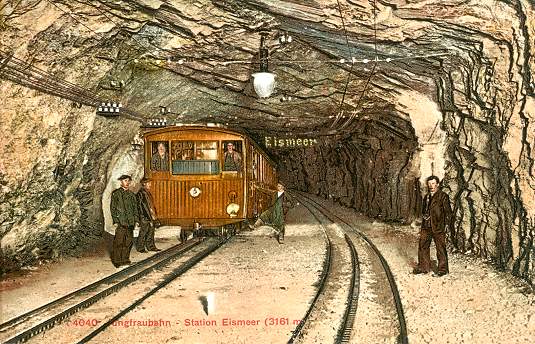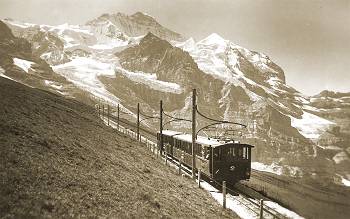

From Photoglob of Zürich, a company that still produces postcards today, we get this view of Eismeer station on the Jungfraubahn in around 1910, at which date Eismeer at 3161 metres above sea level was the upper terminus of the line. The smaller view below from about 1925 is from Verlag Schild-Bichsel of Brienz and shows the line just above Kleine Scheidegg.
From the time that other railways started to serve the Bernese Oberland, engineers looked at the great peaks of the Eiger, the Mönch and the Jungfrau and considered ways, some risible, for tourists to be transported to the top to enjoy the views. In 1893 Zürich industrialist Adolph Guyer-Zeller obtained a concession to build a mountain railway from the Wengernalpbahn (see Postcard) at Kleine Scheidegg to the summit of the Jungfrau using tunnels through the Eiger and Mönch. Capital was raised and construction commenced, with the first section opening from Kleine Scheidegg to Eigergletscher on 19th September 1898. On 2nd August 1899 the line was extended to Rotstock, on 28th June 1903 to Eigerwand and on 25th July 1905 to Eismeer. By opening in stages it allowed revenue to be earned while construction continued. With more difficult tunnelling ahead, the final stage to Jungfraujoch did not open until 1st August 1912. Occasional winter trains had run previously, but from 1926 a winter sports service for skiers was operated from Kleine Scheidegg to Fallboden and from around 1930 to Eigergletscher. Today trains to the summit run all year round, although Eigergletscher is still the limit for skiers.
The 9.3 km railway is built to metre gauge and uses the Strub rack system, designed by Emil Viktor Strub and first used here on the Jungfraubahn. It is electrified at 1125 volts 50Hz three-phase AC with twin overhead wire and twin pantographs, although originally it used 500 volts 38Hz with it being raised in stages over the years, and at first the cars had trolley poles. Hydro-electric power is generated at Lütschental, where the power station also supplies the other railways in the area. Until 1980 there was also a smaller power station at Lauterbrunnen.
 The original rolling stock as shown on our postcards consisted of twelve similar Rowan trains built between 1898 and 1929 by Schweizerische Lokomotiv und Maschinenfabrik (SLM) of Winterthur, jointly with Schweizerische Industriegesellschaft (SIG) of Neuhausen am Rheinfall or Schweizerische Wagons und Aufzügefabrik (SWS) of Schlieren with electrical equipment from AG Brown Boveri & Cie (BBC) of Baden or Machinenfabrik Oerlikon. The Rowan principle was developed by Englishman William Robert Rowan for steam trams, originally with Danish coachbuilders Scandia of Randers, and first tested in Copenhagen in 1876. The steam power unit mounted on a two-axle bogie was enclosed in a passenger carriage, the other end of which was carried on a single axle. In the Jungfrau version the separate electric loco was two-axle but the carriages, built by SIG and SWS were supported at one end from the underframe of the loco and at the other end had a two-axle bogie. The loco was at the downhill end and each unit also pushed a control-trailer. With the change to 50Hz in 1960 the oldest vehicles were withdrawn and scrapped. Complete Rowan train number 1 is now in the Lucerne Transport Museum. Train number 6 has been renovated and is used on the railway for "specials". Locomotives 8, 9, 10 and 11 are used for works duties. The livery of the Rowan cars was brown.
The original rolling stock as shown on our postcards consisted of twelve similar Rowan trains built between 1898 and 1929 by Schweizerische Lokomotiv und Maschinenfabrik (SLM) of Winterthur, jointly with Schweizerische Industriegesellschaft (SIG) of Neuhausen am Rheinfall or Schweizerische Wagons und Aufzügefabrik (SWS) of Schlieren with electrical equipment from AG Brown Boveri & Cie (BBC) of Baden or Machinenfabrik Oerlikon. The Rowan principle was developed by Englishman William Robert Rowan for steam trams, originally with Danish coachbuilders Scandia of Randers, and first tested in Copenhagen in 1876. The steam power unit mounted on a two-axle bogie was enclosed in a passenger carriage, the other end of which was carried on a single axle. In the Jungfrau version the separate electric loco was two-axle but the carriages, built by SIG and SWS were supported at one end from the underframe of the loco and at the other end had a two-axle bogie. The loco was at the downhill end and each unit also pushed a control-trailer. With the change to 50Hz in 1960 the oldest vehicles were withdrawn and scrapped. Complete Rowan train number 1 is now in the Lucerne Transport Museum. Train number 6 has been renovated and is used on the railway for "specials". Locomotives 8, 9, 10 and 11 are used for works duties. The livery of the Rowan cars was brown.
Between 1955 and 1965 ten new 4-axle railcars were purchased from SLM with electrical equipment from BBC. These were originally an orange-red and cream livery. They push matching control-trailers from SWS. In 1992/93 four 8-axle articulated railcars were supplied by SLM with electrical equipment from BBC, with four more coming in 2002 from Stadler with electrical equipment from Bombardier. The livery for these new cars and repaints of earlier cars is a deeper red with yellow stripes. There are also a number of goods vehicles, including small open goods trucks fitted with racks to carry skis.
From a station shared with the Wengernalpbahn at Kleine Scheidegg, the railway climbs in the open to Fallboden where it passes through a 329 metre long avalanche gallery and a 110 metre long tunnel, then climbing to Eigergletscher station. Beyond there it enters the 7,122 metre long tunnel through the mountains in which it remains for the rest of the journey. At Eigerwand and Eismeer stations the train makes short stops so that tourists can get out and walk along side tunnels to take the view through windows in the face of the mountains. The final section is less steep and in fact until 1951 was only partial rack, being fully fitted then to avoid having motor cars that were equipped for both rack and adhesion traction. At the summit at Jungfraujoch you are at the highest railway station in Europe, "Top of Europe" as they like to advertise it, at 3454 metres above sea level.
 The mountain scenery viewed from the Jungfraubahn is as stunning now as it was at the date of these postcards, and a visit to the railways in this region is highly recommended.
The mountain scenery viewed from the Jungfraubahn is as stunning now as it was at the date of these postcards, and a visit to the railways in this region is highly recommended.
![]() After this postcard do you fancy a Swiss fondue? Then try the Fond-U-Like fondue website.
After this postcard do you fancy a Swiss fondue? Then try the Fond-U-Like fondue website.
![]() Go to Postcard Of The Month Index
Go to Postcard Of The Month Index